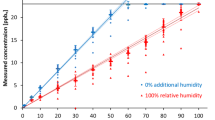Abstract
Objective. The purpose of this study was to assess in the clinical setting the reliability and long-term stability of Raman spectroscopy as implemented in the RASCAL multiple gas analyzer, and to describe/analyze failure modes that manifest in regular use.Methods. Twenty-one RASCAL analyzers were tested for accuracy and precision. Without any prior external calibration or alignment, all gas analyzers were systematically tested over a consecutive 36-hour period with standard gas mixtures. Data were analyzed by evaluating the difference between the predicted value and observed value (bias residual) as reported by each RASCAL. All service data (29 months) also were analyzed for information on durability and failure modes.Results. The RASCAL exhibited a significant tendency to overread high concentrations of agent (isoflurane/enflurane); 4 of 16 instruments misread an agent by more than ±0.30%. Four of 16 instruments could not properly identify volatile agents in low concentrations (0.31 vol%). Inventory records show that water contamination led to the replacement of gas sample sets an average of 1.5 ± 1.2 times per case over the 29-month period. Although many instruments had not been externally calibrated for over 63 days, linearity proved acceptable for CO2, O2, N2O, and N2. A rationale for instrument behavior and major failure modes, based on the instrument design, was developed.Conclusions. The manufacturer’s suggested calibration intervals (30 days) were found to be more than adequate for reliable gas analysis using Raman spectroscopy. Without the benefit of frequent calibrations and as time passes, volatile agent quantification can be expected to drift significantly upward.
Similar content being viewed by others
References
Van Wagenen RA, Westenskow DR, Beener RE, Gregonis DE, Coleman DL. Dedicated monitoring of anesthetic gases by Raman scattering. J Clin Monit 1986 2: 215–222
Westenskow DR, Smith KW, Coleman DL, Gregonis DE, Van Wagenen RA. Clinical evaluation of a Raman scattering multiple gas analyzer for the operating room. Anesthesiology 1989; 70: 350–355
Gregonis DE, Van Wagenen RA, Coleman DL, Mitchell J. A commercial anesthetic-respiratory gas monitor utilizing Raman spectroscopy. Raman and luminescence spectroscopies in technology II. Proceedings of the International Society of Optical Engineering: 1990; 1336: 247–255
RASCAL maintenance documents. Salt Lake City: Albion Instruments, 1989
Bland JM, Altman DG. Statistical methods for assessing agreement between two methods of clinical measurement. Lancet 1986; l: 307–310
Optical filter guide. Salem, NH: Andover Corporation, 1990
Author information
Authors and Affiliations
Additional information
The RASCAL multiple gas analyzer is no longer available
Rights and permissions
About this article
Cite this article
Lawson, D., Samanta, S., Magee, P.T. et al. Stability and long-term durability of raman spectroscopy. J Clin Monitor Comput 9, 241–251 (1993). https://doi.org/10.1007/BF02886694
Received:
Revised:
Accepted:
Issue Date:
DOI: https://doi.org/10.1007/BF02886694




